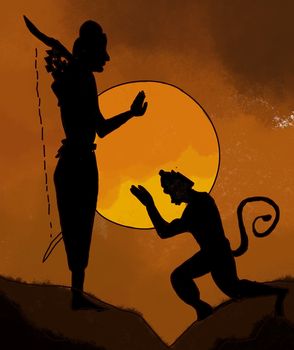Ram Navami is the Hindu festival that celebrates the birth of Lord Ram. As a child, growing up in north India, I don’t remember major public celebrations of Ram Navami, the sort that we witness on Holi, Dussehra or Diwali in Delhi. My maternal grandmother would keep a fast on the day and go to the Ram temple. We, children, would devour the prasad she brought home. But, much like the figure of Ram himself, Ram Navami as a festival has transformed in the years since the BJP has risen to and finally assumed total political power in India.
As a child, every story I heard about Lord Ram, every comic I read, every bhajan we heard, every translated adaptation of the epic one read painted the picture of a man whose godliness was his righteousness. Ram was so righteous, so abhorring of personal greed or gains, and so committed to the idea of justice, that he willingly lost his kingdom and lived for over a decade in exile in a forest and finally renounced the wife that he had fought a war to rescue! One never imagined Ram to be angry or aggressive—those qualities belonged to his brother Lakshman.
One always imagined Ram as gentle, wise, kind, smiling and forgiving. Weeping when he lost Sita, weeping when Lakshman was mortally wounded. Even as an ace warrior, in popular imagination, it never seemed like Ram was enjoying the violence and fighting—he was doing his dharma dispassionately. And he was certainly never flexing at, nor provoking his enemies. Even the posters and pictures one saw of Ram were always smiling and pleasant, his bow always strung on his shoulder and a hand raised in blessing.
It was only once the RSS-BJP began to mobilise support in the early 1990s that an aggressive and militarised imagery for Lord Ram entered the Indian public imagination. As the traditional and more gentle north Indian greeting ‘Jai Siya Ram’ (Hail Sita’s Ram) got transformed into the war cry ‘Jai Shri Ram’ (Victory to Lord Ram), the figure of Ram was depicted mid shot—bow strung with arrow ready to strike. As graphic design technology developed so did the muscles in Ram’s body. The same happened with the figure of Lord Hanuman. My favourite God in my childhood, Hanuman, was always jovial and playful and fun and nice in my imagination, his godliness and powers coming from his humility and devotion. I remember wondering back in 2013 as I stared at the now omnipresent black and orange Hanuman sticker behind a taxi, “Why is Hanuman ji so angry?”
Like Ram and Hanuman, the festival of Ram Navami, too, has transformed. It may have started some years prior but especially since the BJP came to power in 2014, Ram Navami has become a day for hindutva organisations to take out processions that have often been called ‘Shobha Yatras’ (Glory Processions). In many towns and cities in India, saffron-clad men take out marches wielding weapons like sticks and swords. A study by the Citizens & Lawyers Initiative titled ‘Routes of Wrath: Weaponising Religious Processions’ examined the communal violence during Ram Navami and Hanuman Jayanti festivals in April 2022, and found that most processions chose routes that passed through Muslim majority areas.
This year Ram Navami has coincided with the holy month of fasting and prayer for Muslims—Ramadan. The utter vileness and moral depravity of harassing those in prayer during their festival is blatant. The psychological and emotional assault on the Muslim psyche in India is evident. It is alleged that in Howrah in West Bengal, and in some cities in Bihar, Muslims responded with stone pelting, and communal clashes ensued.
Some made use of this and highlighted only these clashes, stressing that Muslims were rioters, ignoring the cause, context and even the numerous other incidents that had taken place across states; with no retaliation from Muslims.
The irony that Maryada Purshottam Ram’s ‘so-called’ devotees are completely devoid of any decency or basic humanity is only a sign of our time—Ravans donning the colours and crown of our righteous Ram.
The writer is an award-winning Bollywood actor and sometime writer and social commentator.


